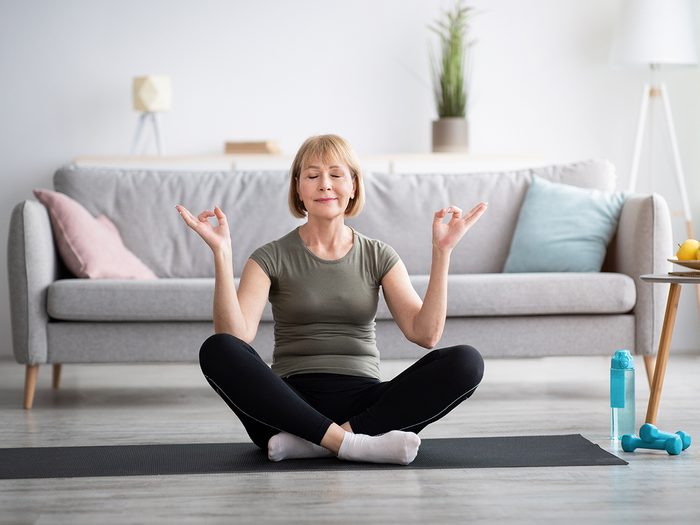
Staying healthy with yoga
Mentally, getting old isn’t so bad. Physically, it can feel like it’s all downhill after 18. We lose flexibility, balance and strength—especially once we hit our 30s — and the aches and pains pop up out of nowhere.
But there’s an easy way to keep your body in top shape as the decades roll by. Yoga is a low-impact way to strengthen and stretch and can be done any time and just about anywhere. We asked Toronto yoga teacher Christine Felstead to guide us through some poses that will keep our body feeling good.
Felstead recommends doing the whole sequence a few times a week up to daily at whatever time of day fits your schedule. Start by doing each pose for about five deep breaths and increase from there when you feel ready. If the whole sequence is too much, work the poses into your routine wherever they might fit. If you need a break during the sequence of poses, try child’s pose—sit on your heels, lower your head to your knees, and keep arms alongside the body or out in front. Focus on the breath moving in and out of the body, and let yourself relax.
As always, if you have any concerns about starting a new routine, speak to your doctor. A qualified yoga teacher will be able to answer any questions about the details of the poses. And remember: Don’t forget to breathe!
(Related: 4 Stretches to Improve Range of Motion as You Age)
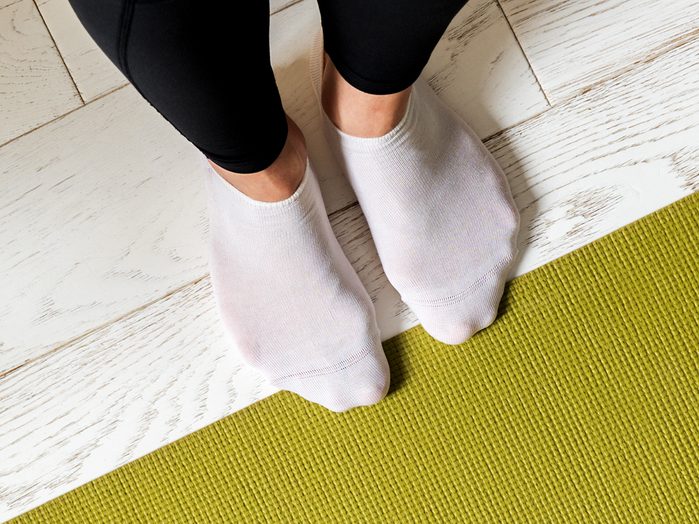
1. Equal standing
Felstead says this pose will help you develop awareness of postural tendencies.
- Without shoes, stand on a yoga mat or the floor with feet parallel and together or hip-width apart, arms hanging at sides.
- Focus on your feet and how your body weight is distributed. Without lifting the soles of your feet off the floor, shift forward, backward and side to side to move your body weight until you bring it to the centre.
- Moving your attention up the body, feel that your hips are stacked over your ankles, shoulders over hips. Move your chin back so that the skull is balanced on the spine. Aim to find an equilibrium that means you’re using as little muscle strength as possible to stand.
- Imagine that a string is pulling you up from the crown of your head.
Change it up: Close your eyes and notice how your balance changes. Or try doing the pose in front of a mirror and compare how you feel with how straight and even you look.
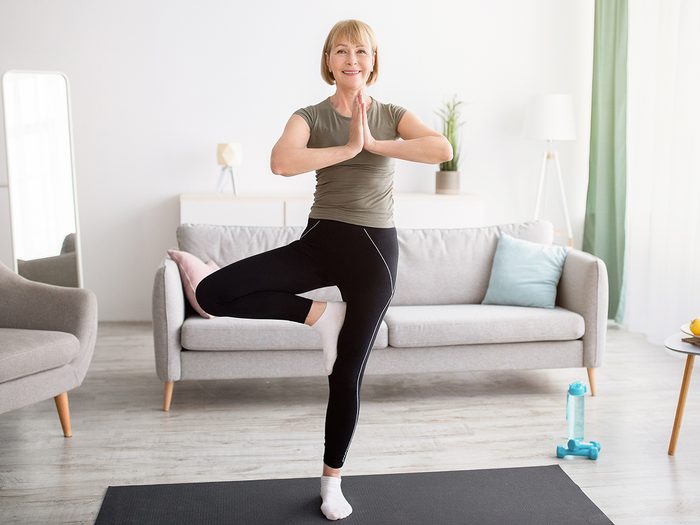
2. Tree pose
Balance is notoriously more difficult as we age, says Felstead. Tree pose is a simple balancing posture that will help you maintain your abilities.
- Start in equal standing posture, then shift most of your body weight onto your left foot. Bring your hands to prayer position in front of your chest.
- If your balance is unsteady, keep your right toes on the floor, right heel against the inside of the left calf. If you feel stable here, lift the right foot off the floor and place it against the inside of the left calf or thigh, being careful not to press against the knee.
- Take a few breaths, then slowly lower and repeat on the second side.
Change it up: Challenge your balance by reaching the arms above the head or by looking up toward the ceiling.
(Related: 5 of the Best Exercise Bikes for Seniors)
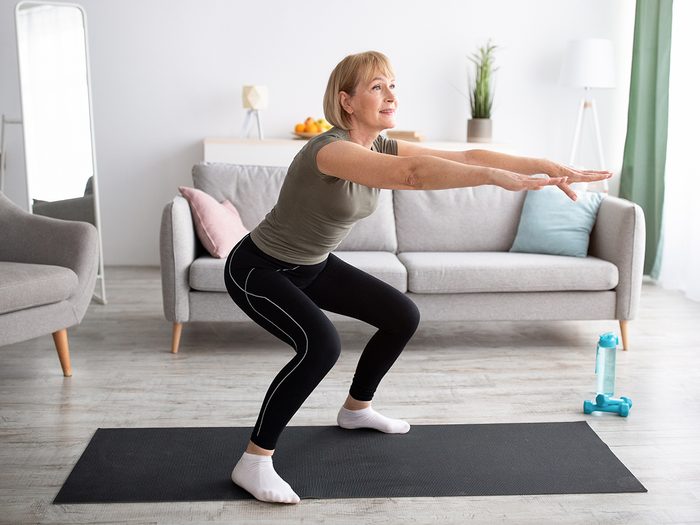
3. Squat
Strong thigh muscles will help protect the knees from pain and injury, says Felstead.
- Start in equal standing posture with feet together and arms at sides.
- Keeping the knees and feet together, sit back as though you were going to sit in a chair. Only go as far as you are comfortable and balanced, but try to challenge your muscles. To protect your knees, make sure they stay behind your toes.
- Reach your arms straight in front of you to help with balance.
Change it up: If it’s easier to balance, you can do this pose with feet hip-width apart—just be sure your knees are pointed in the same direction as your toes and not caving inward. Play with how deep you can go while maintaining an erect spine.
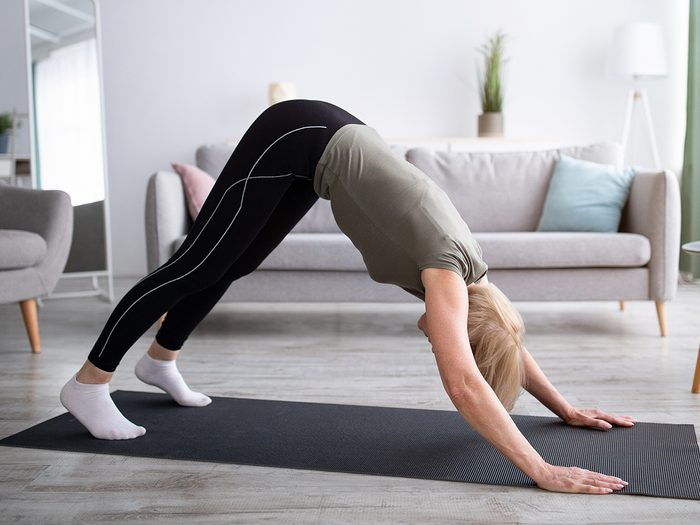
4. Downward dog
A classic and well-known yoga posture, downward dog improves upper-body strength, promotes a healthy spine and stretches the back body.
- Start on your hands and knees, with wrists under shoulders and knees under hips. Your fingers should be spread wide and engaged, with middle fingers pointing forward. Look behind you and check that feet are about hip width apart.
- Curl under the toes and reach your tailbone toward the ceiling. At this point, keep your heels high off the floor and keep a gentle bend in your knees.
- Gently straighten your knees and lower your heels toward the floor (it’s unlikely that they’ll touch) until you feel a soft stretch in the back of your legs and in your back. If it feels too strong, bend your knees again until you’re more comfortable. Those who are unflexible might want to take their feet a bit farther apart.
- Rather than dumping all the weight onto your shoulders, aim to balance it between your hands and feet. Engage your hands and arms as though you were reaching forward with your hands. Bring your belly button toward your spine and engage your core rather than sinking at the ribs.
Change it up: To work flexibility, especially in the morning, pedal your feet so that you’re stretching one leg then the other. If you feel strong enough and your shoulders are happy, you can gently flow from downward dog straight into plank pose.
(Related: The Awesome Health Benefits of Awe Walking)
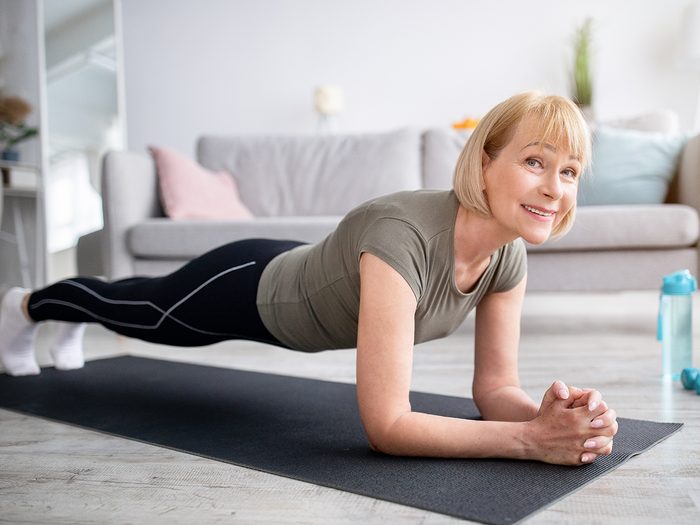
5. Plank
This pose works your upper body and core strength, both of which can decline as we age.
- Start on your hands and knees, making sure that your wrists are directly under your shoulders and your hands are engaged.
- For level one, walk back on your knees until there’s a fairly straight line from your knees to your shoulders. Bring your belly button toward your spine and use your core muscles to keep your hips from sinking. Make sure your wrists are still directly under your shoulders.
- For level two, move off your knees and onto your toes so that your entire body is in a straight line from shoulders to heels.
Change it up: If this pose hurts your wrists, move down onto your forearms instead, with your hands clasped and your elbows under your shoulders. Once level two gets easier, challenge yourself by lifting alternating feet for a breath or two each.

6. Seated twist
Twists promote a healthy spine and can relieve back muscles tight from too much sitting.
- Sit in a comfortable cross-legged position with your spine upright. If you find yourself uncomfortable or slouching, try placing a folded blanket, cushion or yoga block under you to bolster your hips.
- Inhale and sit up as straight as possible. On the exhale, twist gently to the right, starting the movement from the base of your spine and letting it flow upward. As you move, place your left hand on your right knee and your right hand behind you for balance. Move your head last and only as far as it can comfortably go without strain.
- On each inhale, lengthen your spine—you will likely move slightly out of the twist. On each exhale, gently twist deeper.
- Return to the centre on an inhale, then repeat on the left, making sure to switch the crossing of your legs first.
Change it up: For a more relaxing version of this simple pose, try a reclined twist.
Next: Workout Gear, Clothing and Tech That’ll Keep You Moving When It’s Cold
